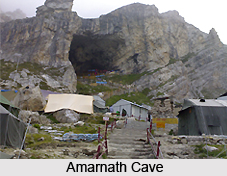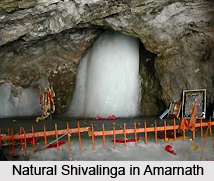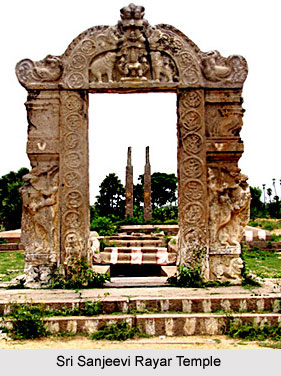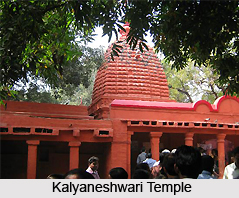 Amaranth is one of the ancient Hindu shrines which is accounted to be 5000 years old. Dedicated to Lord Shiva Amarnath Caves is reckoned as a holy shrine. About 400,000 people visit during the 45 days season around the festival of Shravani Mela in July-August, coinciding with the Hindu holy month of Shravan. Located at the top of the hill the cave consists of an ice stalagmite that takes the shape of a Shiva and completes its formation in the month of Shravan. This is most auspicious month for the Hindu pilgrims who travel from all over the world to have a glance of this shrine and pay homage to Baba Amarnath. Along with the main Shiva lingam two more Shiv lings or stalagmites are found which are named as Goddess Parvati and Lord Ganesha.
Amaranth is one of the ancient Hindu shrines which is accounted to be 5000 years old. Dedicated to Lord Shiva Amarnath Caves is reckoned as a holy shrine. About 400,000 people visit during the 45 days season around the festival of Shravani Mela in July-August, coinciding with the Hindu holy month of Shravan. Located at the top of the hill the cave consists of an ice stalagmite that takes the shape of a Shiva and completes its formation in the month of Shravan. This is most auspicious month for the Hindu pilgrims who travel from all over the world to have a glance of this shrine and pay homage to Baba Amarnath. Along with the main Shiva lingam two more Shiv lings or stalagmites are found which are named as Goddess Parvati and Lord Ganesha.
Amarnath Cave
Amarnath Caves is situated at a height of 3888m, about 141 km from Kashmir`s capital city in summer, Srinagar. The area is under the control of the Indian Army. Due to terrorist intimidation this place is under severe protection. Devotees generally take the 45 km pilgrimage on foot from the town of Pahalgam, about 96km from Srinagar, and cover the journey in 4-5 days. There are two routes to reach the temple- one the more conventional and the longer path from Srinagar and the other a shorter course from the town of Baltal. Some devotees predominantly opt for the old route and can use horseback riding to make the journey. The cylindrical ice formation resembling a Shiva-linga, which waxes during May to August and gradually ebbs thereafter. The cave which faces south is about 150 feet high and 90 feet wide and its walls are made with gypsum. Within the cave, there are two gaps. Of the two gaps, one is bigger and it is below this gap that the ice formation resembling Shiva-linga representing the main deity is formed by the drops of water dripping from the top of the cave. It is believed that the water is coming from the holy Ramkund Lake, situated above the cave.
 Shivlingam of Amarnath
Shivlingam of Amarnath
The Shivalimgam measures up to 200-cubic metre inside the cave which come up to 12 ft. which shrinks down with growing winter. A strange feature of the shrine is that rises in height when the atmosphere outside the cave is warmer and shrinks during the winters. The other ice lingams, representing Parvati and Ganesh however, remained unharmed. Amarnath is reported to be 5000 years old and has been mentioned in ancient Hindu texts. This lingam of Shiva is said to grow and shrink with the phases of the moon, reaching its height during the summer festival. According to the Hindu mythology, this is cave where Lord Shiva told about the secret of Life and eternity to His divine consort, Parvati, and hence this shrine holds a singular value for the Hindus. This celestial exchange was overheard by a pair of doves, who became immortal and made this cave their eternal abode. Pilgrims can see the doves even now.
Legends of Amarnath Cave
The exact discovery of the cave is incomprehensible, though it is commonly believed that a `Gujjar` (natives of Kashmir) shepherd found the cave, where a saint gave him a mysterious gunny bag. When he returned home he found them to be gold coins, and this made the entire village excited and believed that the cave is home to the Lord. Another legend speaks of a Hindu rishi, Kashyap who drained the lake of Kashmir and found the cave along with the lingam in it. This latter legend might be alluding to the geological transformation of this region, when the massive sea in this part was compressed by the Indian geological plate to form the Himalayas.
Amarnath Yatra
Amarnath cave is well known for Amaranth Yatra. According to the Hindu faith, the yatra begins on Ashadha Poornima (Full Moon Day of Hindu month `Ashadha`) and ends on Sharavana Poornima (Full Moon Day of Hindu month `Sharavana`). The two-month Yatra is conducted amidst tight security and unfavourable weather conditions.
Devotees believe that one can attain redemption by witnessing this ice Shiva lingam. The cave is dark inside and there is another small cave on the left of the Linga from which a chalk-like substance is dug out. This substance is given to the pilgrims as vibhuti (sacred ash) of Amarnath by the Mohamedans of the Batkut village. Thus Amarnath caves are one of the most revered shrines of India. Located as the crown of India this holy is flooded by the devotees in the month of Shravana. Surrounded with huge glaciar this is one of the biggest excitement for every Hindu.





















